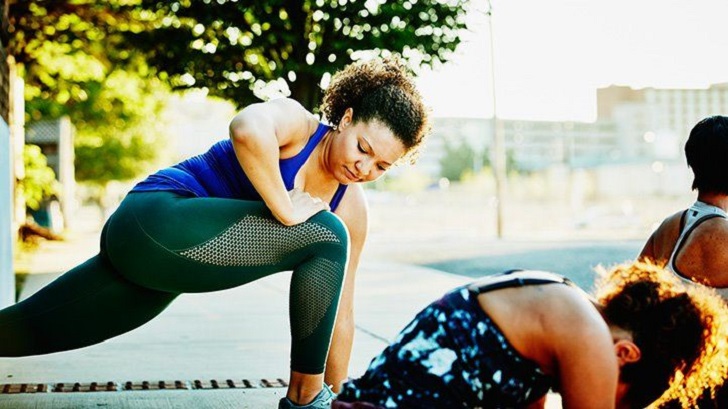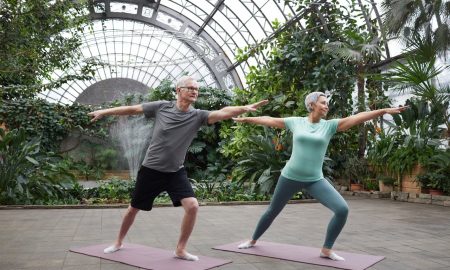
Stretching: Health Benefits, and Getting Started

Stretching is essential to any exercise routine and can be done as a standalone activity. It involves moving your muscles and joints through various motions to increase flexibility, reduce muscle tension, and improve overall mobility.
Stretching can be performed before and after exercise or anytime throughout the day to help promote good posture, reduce stress, and improve circulation. This article will discuss stretching, its health benefits, and how to get started.
What Is Stretching?

Thomas Barwick/ GettyImages | You are only as young as your spine is flexible
Stretching involves moving the muscles and joints in your body through a range of motions. It can be done statically, by holding a position for a certain amount of time, or dynamically by moving in and out of a stretch. There are many different types of stretches, including:
- Static stretching: holding a position for 10-30 seconds
- Dynamic stretching: moving in and out of a stretch
- PNF stretching: involves contracting and relaxing the muscle during the stretch
- Active stretching: uses the muscles opposite the target muscle to facilitate the stretch
- Passive stretching: uses a partner or external force to assist in the stretch
What Are the Health Benefits of Stretching?
Improved Flexibility
Stretching can help increase your range of motion and flexibility, reducing the risk of injury during physical activity.
Reduced Muscle Tension
It can also reduce pain and improve circulation, reducing muscle tension and increasing blood flow.
Improved Posture
Stretching can help improve your posture by lengthening tight muscles and strengthening weak ones.

Gretchen Reynolds/ Getty Images | Your life is worth a lot more than you think
Reduced Stress
By stretching, you reduce stress by promoting relaxation and reducing tension in the body.
Improved Athletic Performance
Stretching before and after exercise can help improve athletic performance by increasing flexibility and reducing the risk of injury.
Getting Started With Stretching
Start Slow
It’s important to start slowly and gradually increase the intensity and duration of your stretches over time. If you’re new to stretching, start with a few simple stretches and gradually work up to more advanced ones.
Warm Up First
Before stretching, you should always warm up your muscles to reduce the risk of injury. This can be done by performing a light aerobic activity or dynamic stretching.
Stretch All Major Muscle Groups
Stretching all major muscle groups, including your arms, legs, back, and neck, is crucial. This will help ensure that your entire body is flexible and mobile.

Thomas Barwick/ GettyImages | Stretching every day keeps the sore muscles away
Hold Each Stretch for At Least 10-30 Seconds
Hold each stretch for at least 10-30 seconds to benefit most from your stretches. This will give your muscles time to relax and lengthen.
Don’t Push Too Hard
Listen to your body, and do not push too hard when stretching. You should feel a mild stretch but not pain.
Breathe Deeply
It’s important to breathe deeply and rhythmically while stretching. This will help promote relaxation and reduce tension in the body.
Stretch Regularly
Try stretching into your daily routine, before or after exercise or anytime throughout the day.
More in Nutrition & Weight Loss
-
`
Amanda Bynes Pregnant at 13? Debunking the Rumors
In recent years, the internet has been ablaze with rumors surrounding former child star Amanda Bynes, particularly regarding allegations of a...
July 1, 2024 -
`
Can Baking Soda Clean Your Lungs?
Years of inhaling cigarette smoke, pollution, and other toxins can leave you longing for a way to cleanse your lungs. The...
June 27, 2024 -
`
How to Build Muscle Mass After 60? 5 Proven Strategies
Curious about how to build muscle mass after 60? You are not alone. And the good news is that it is...
June 20, 2024 -
`
Prediabetic Foods That Can Lower Your Blood Sugar in 2024
Prediabetes is a health condition characterized by blood sugar levels that are higher than normal but not high enough to be...
June 13, 2024 -
`
Kelly Clarkson’s Weight Loss Journey | Here Are the Details
Kelly Clarkson’s weight loss has been a hot topic among fans and media alike. The iconic American singer and host of...
June 3, 2024 -
`
Essential Vitamins for Gut Health – A Comprehensive Guide
Our gut does more than just digest food – it plays a vital role in immunity, mood, and overall health. But...
May 30, 2024 -
`
Looking to Build A Stronger Sculpted Back? Try Cable Back Workouts
Back workouts using cables, or cable back workouts as they are commonly known, have become the gold standard for anyone aiming...
May 22, 2024 -
`
How Much Water Should I Drink on Creatine? Hydration Tips
Creatine, a popular supplement among athletes and fitness enthusiasts, has gained widespread recognition for its ability to enhance muscle strength, power,...
May 17, 2024 -
`
What Is Bruce Willis’s Net Worth? Get the Inside Scoop Here!
Bruce Willis, the action hero who has saved the day countless times on screen, has built a legendary career. But how...
May 11, 2024















You must be logged in to post a comment Login